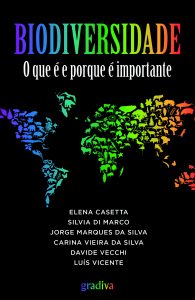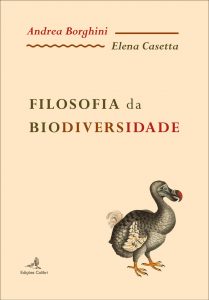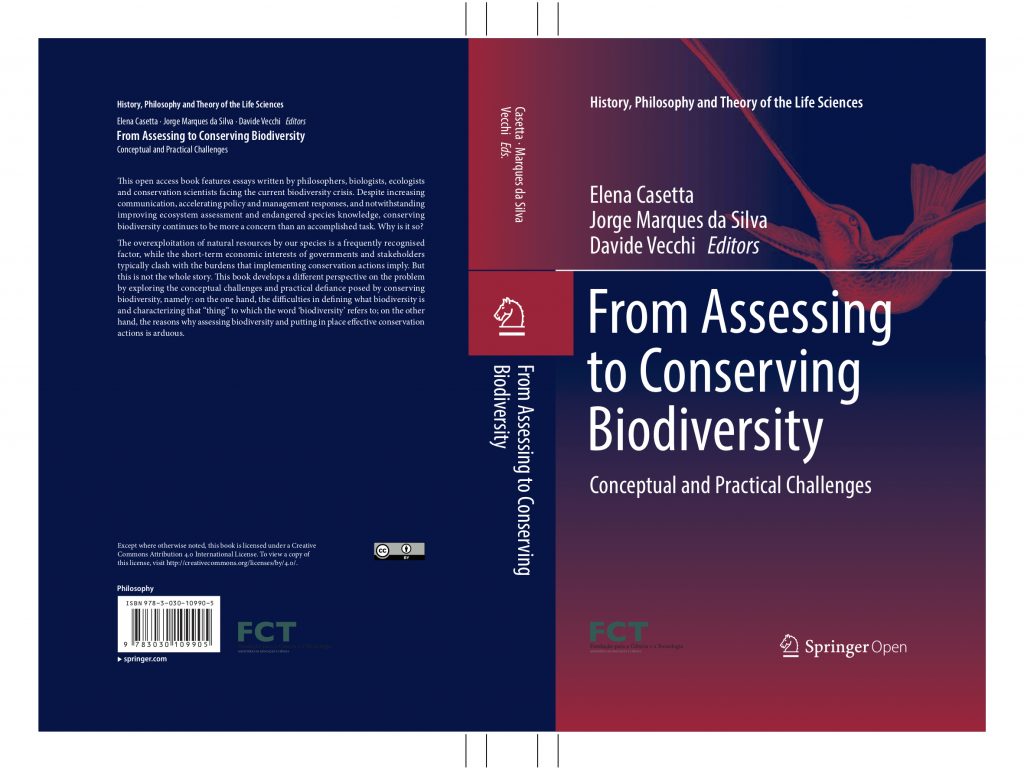
Biodiversidade. O que é e porque é importante
E. Casetta, S. Di Marco, C. Vieira da Silva (Org.)
Gradiva, 2018
A nossa vida e a vida das gerações futuras dependem da biodiversidade. Porém, a biodiversidade está em risco desde que a nossa espécie emigrou de África, há cem mil anos. Posteriormente, com o desenvolvimento da agricultura, intensificou-se aquilo que muitos investigadores designam como “Sexta Grande Extinção”, uma perda drástica de espécies provocada pelas actividades humanas. Contudo, a biodiversidade não pode ser simplesmente identificada com as espécies que povoam o planeta, e explicar exatamente o que ela é, e porque é importante conserva-la não é nada simples. Este livro, que inclui contribuições de biólogos e filósofos, expõe estes temas de forma clara e acessível a um público não especializado, oferecendo uma abordagem simples, mas ao mesmo tempo cientificamente informada, a um tópico extremamente complexo.
Sumário
Introdução
Parte I – O que é a biodiversidade
Cap. 1 – O inventário da vida (E. Casetta)
Cap. 2 – Biodiversidade e evolução (D. Vecchi)
Cap. 3 – O que é a biodiversidade? A perceção do público comum (C. Vieira da Silva)
Parte II – A importância da biodiversidade
Cap. 4 – Biodiversidade entre Economia e Ecologia (L. Vicente)
Cap. 5 – Biodiversidade e serviços do ecossistemas (S. Di Marco)
Cap. 6 – Biodiversidade agrícola (J. Marques da Silva)

Filosofia da biodiversidade
A. Borghini & E. Casetta
Edições Colibri, 2018
O conceito de “biodiversidade” é extremamente intuitivo: a diversidade das forma de vida cerca-nos. Basta-nos olhar para un jardim, um parque ou um fundão no mar para nos apercebermos disso, e quando ouvimos falar de biodiversidade, mais ou menos todos nos entendemos. E contudo, a diversidade dos seres vivos é tào óbvia quào dificil de definir e analisar de modo sistemático e definitivo. O objectivo deste livro é introduzir o leitor nas principais questões filosóficas sobre a biodiversidade e esclarecer alguns aspetos conceptuais particularmente significativos e, por vezes, controversos, que emergem na definição, medição e conservação da biodiversidade.
Sumário
0 INTRODUÇÃO
1 A BIODIVERSIDADE
1.1 Um conceito elusivo
1.2 A classificação da biodiversidade
1.3 A descrição da biodiversidade
1.4 A conservação da biodiversidade
2 AS ESPÉCIES
2.1 A centralidade das espécies
2.2 Em busca de uma definição
2.3 Os principais conceitos de espécie
2.4 Há Espécie e espécies: um diagnóstico e a vida difícil do realista
2.5 O nominalismo
2.6 O pluralismo
2.7 Uma solução radical
3 BIODIVERSIDADES ANTROPOCÊNTRICAS
3.1 Comida e biodiversidade
3.2 Biodiversidade e biotecnologias
3.3 Conclusões
Bibliografia
Forthcoming
 From Assessing to Conserving biodiversity. Conceptual and Practical Challenges
From Assessing to Conserving biodiversity. Conceptual and Practical Challenges
Eds. E. Casetta, D. Vecchi, J. Marques da Silva
Springer Series “History, Philosophy and Theory of the Life Sciences”
Forthcoming 2019
This open access book features essays written by philosophers, biologists, ecologists and conservation scientists facing the current biodiversity crisis. Despite increasing communication, accelerating policy and management responses, and notwithstanding improving ecosystem assessment and endangered species knowledge, conserving biodiversity continues to be more a concern than an accomplished task. Why is it so?The overexploitation of natural resources by our species is a frequently recognised factor, while the short-term economic interests of governments and stakeholders typically clash with the burdens that implementing conservation actions imply. But this is not the whole story. This book develops a different perspective on the problem by exploring the conceptual challenges and practical defiance posed by conserving biodiversity, namely: on the one hand, the difficulties in defining what biodiversity is and characterizing that “thing” to which the word ‘biodiversity’ refers to; on the other hand, the reasons why assessing biodiversity and putting in place effective conservation actions is arduous.
Chapter 1 Biodiversity healing. An Introduction
E. Casetta, D. Vecchi, J. Marques da Silva
PART I – Estimating biodiversity: data collection and monitoring challenges
Chapter 2 The hidden biodiversity data retained in pre-Linnaean works: a case study with two important XVII century Italian entomologists
F. Andrietti, C. Polidori
Chapter 3 Marine biodiversity databanks
A. Barberousse, S. Bary
Chapter 4 Problems and questions posed by cryptic species. A framework to guide future studies
A. Chenuil, A. Cahill, N. Delemontey, L. E. Du Salliant du Luc, H. Fanton
Chapter 5 The importance of scaling in biodiversity
L. Borda-de-Água
Chapter 6 Measures of biological diversity. Overview and unified framework
V. Crupi
PART II – Characterizing biodiversity: beyond the species approach
Chapter 7 Essential biodiversity change indicators for evaluating the effects of Anthropocene in ecosystems at a global scale
C. Branquinho, H.C. Serrano, A. Nunes, P. Pinho, P. Matos
Chapter 8 Are species good units for biodiversity studies and conservation efforts?
T. Reydon
Chapter 9 Why a species-based approach to biodiversity is not enough. Lessons from multispecies biofilms
J. Marques da Silva, E. Casetta
Chapter 10 Considering intraindividual genetic heterogeneity to understand biodiversity
E. Boon
Chapter 11 Biodiversity, disparity and evolvability
A. Minelli
Chapter 12 Can plasticity lead to the emergence of novel units of biodiversity?
D. Vecchi, R. Mills
Chapter 13 Between explanans and explanandum: biodiversity and the theoretical unity of ecology
P. Huneman
Chapter 14 Functional biodiversity and the concept of ecological function
A. Dussault
Chapter 15 Integrating ecology and evolutionary theory: A game changer for biodiversity conservation?
S. Di Marco
PART III – Conserving biodiversity: from science to policies
Chapter 16 On the impossibility and dispensability of defining “biodiversity” – and its function as a mediator between heterogeneous fields
G. Toepfer
Chapter 17 The vagueness of “biodiversity” and its implications in conservation practice
Y. Meinard, S. Coq, B. Schmid
Chapter 18
What should “biodiversity” be?
S. Sarkar
Chapter 19 Natural diversity: how taking the bio- out of biodiversity aligns with conservation priorities
C. Santana
Chapter 20
Ordinary biodiversity. The case of food
A. Borghini
Chapter 21
Conservation sovereignty and biodiversity
M. Oksanen, T. Vuorisalo

